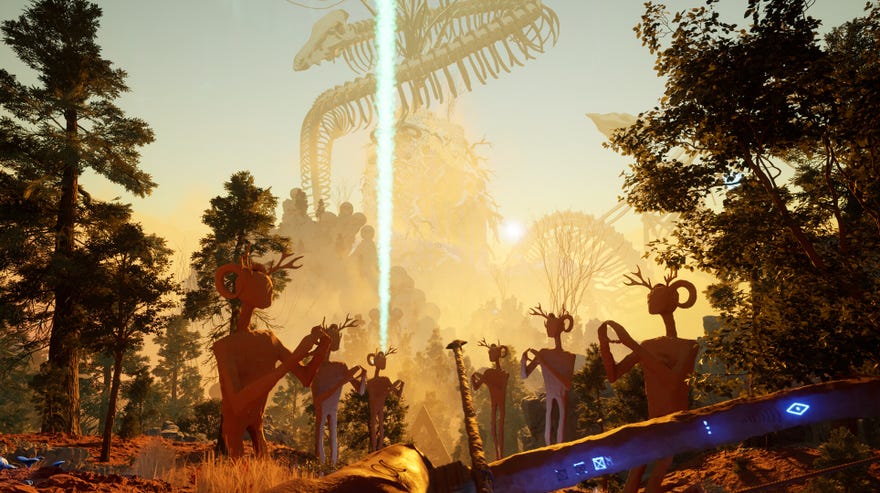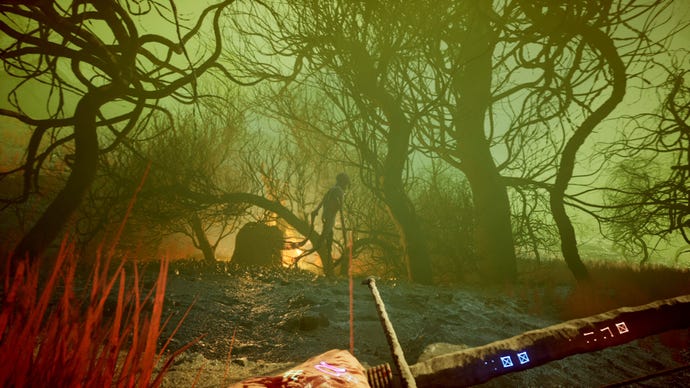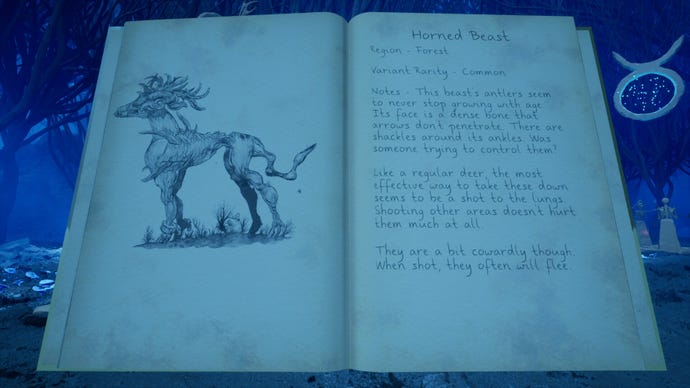HomeFeaturesThe Axis Unseen
The Axis Unseen channels years of Skyrim design experience into a spooky, open world hunting gameWe play ex-Bethesda developer Nate Purkeypile’s first indie game
We play ex-Bethesda developer Nate Purkeypile’s first indie game
Image credit:Just Purkey Games
Image credit:Just Purkey Games

A heaving expo floor is not a great place to sample a first-person open world hunting game that wants you to monitor your own heartbeat, butThe Axis Unseenmanages to be pretty atmospheric regardless. It helps that I’m hunting Bigfoot. Hefting my magical bow, I peer around a tree trunk at the creature as he wanders down a slope of vivid orange grass sprinkled with pale blue rock. I only have a couple of arrows in my quiver, which doesn’t feel like nearly enough, so I edge across the hillside to another tree trunk, where I can hopefully line up a headshot.
Whether due to the rattle of my feet on stone or the wind carrying my scent, Bigfoot notices my presence immediately. He starts to amble towards me, the thump of his strides registering through the controller. I panic, draw an arrow, and send it flying into his shoulder. Bigfoot doesn’t like that. He’s so angry he gets himself stuck on the geography. But he frees himself after a second or two’s moonwalking, then gallops over the intervening ground and wallops me into the air. In a miserable failed imitation of Doom Eternal, I fire off the second arrow while I’m airborne and miss completely. Bigfoot chases me into the forest, and the demo ends soon after.
Image credit:Just Purkey Games

In addition to skeletons bigger than buildings, The Axis Unseen harbours a few Skyrim-esque smaller boneheads that, who knows, might indicate the position of a lore titbit or useful item of some kind. |Image credit:Just Purkey Games

Among the things the game doesn’t share with Skyrim et al are dungeons. “It’s all out in the open,” Purkeypile says. “Part of that is I have some very, very big creatures, and that’s harder when you have dungeons. I want to say the tallest one is like ten storeys tall. I kind of need that breathing room for these characters. I’m a solo dev - I think a game that’s already five times the size of Skyrim is probably enough play space!”
Possibly and not unreasonably anticipating a headline like ‘Skyrim designer’s next game is five times the size of Skyrim’, he swiftly adds that the old Bethesda games “have different focuses for why that would be”. As Purkeypile sees it, “Skyrim is about going to a dungeon and exploring the dungeon. This is a hunting game. I actually tried a smaller world, and it doesn’t play right - you need wilderness to create breathing room between the spaces. Otherwise, it just feels like Disneyland, which can work well for some games but doesn’t work well for a hunting game.”
The world of The Axis Unseen is also, to some degree, an extension of the interface, even before you get access to sensory power-ups that, for example, highlight particles of scent on the breeze. In the biome I visit during my demo, the environmental colour scheme is carefully broken up to aid navigation and planning. If you’re still recovering fromrecent debatesabout developers marking interactive fixtures with yellow paint, you might find this ‘UI-fication’ of the landscape displeasing, but it suits the game’s mildly addled cosmic vibe - and there are basic production considerations, too.
The Axis Unseen - IGN’s Fear Fest Gameplay TrailerWatch on YouTube
The Axis Unseen - IGN’s Fear Fest Gameplay Trailer

“It’s this sort of exaggerated style, where it’s mostly flat colours with tonnes of detail, because it does matter a lot whether you’re walking on rocks versus dirt, because you’re louder in the process,” Purkeypile goes on. “So it’s really important that the player knows that, but also for a solo indie dev, it’s easier to complete the game this way, because I don’t have to do as much texture. So like, it plays better, it looks better - it looks more distinct.”
Purkeypile says he gave the writers relatively little guidance beyond asking them to spread their tales out across the game’s six regions. “Those stories are essentially their own. Folklore is about telling stories. And if I don’t have like a specific gameplay thing that I need to tell people through those journals, I think it’s more interesting to just have it be about like world-building and expanding that, and things having their own voice that way, too. Not just me writing a bunch of stuff.”
The lore books will also clue you in on the behaviours of the game’s monsters, who range from the merely threatening, such as Bigfoot, to creatures that are straight out of a ‘proper’horror game. There’s a deer-type creatures with grotesquely overgrown antlers that will charge at you then run away, and werewolves who will actively stalk you. “It gets weirder and weirder as you get later in the game,” Purkeypile says. “There’s this area of cloaked in darkness, with all this fog everywhere. And you have this tattoo that [lights up] when something moves, but there’s a creature that only moves when you’re not looking at it. So you’re like, I know something’s moving. But every time I look around, I don’t know where it is.”
Image credit:Just Purkey Games

To bring down such horrors, you’ll probably need posher ammunition. There are arrows that affect the wind, set things on fire, slow time and create remote viewing points for scouting. There are also non-arrow-based spells to cast, and power-ups that, say, stop your heartbeat growing so loud that you can’t hear creatures approaching you from behind.
The monsters are, alas, probably the aspect of The Axis Unseen that needs most work right now. Their animations are wooden and unconvincing, more suggestive of dads dressed in munster suits for somebody’s birthday than beasts out of myth, and as my brief encounter with Bigfoot reveals, they have a tendency to get stuck on the scenery. Nonetheless, I’m excited to play more of the game, which feels both like a continuation ofcertain approaches from Purkeypile’s Elder Scrolls daysand the work of a seasoned fantasy geographer now free to do things those games didn’t allow for. Is this a fair characterisation, I ask Purkeypile in closing?
“Yeah, I think that’s accurate,” he says. “Some people are like, ‘Oh, you’re making Stealth Archer: The Game’. But then it is within my own trappings of what I’m going to do with that combat and that experience of building an open world. It all works out pretty well for what kind of indie game I think I can make, having made boatloads of games like that.”